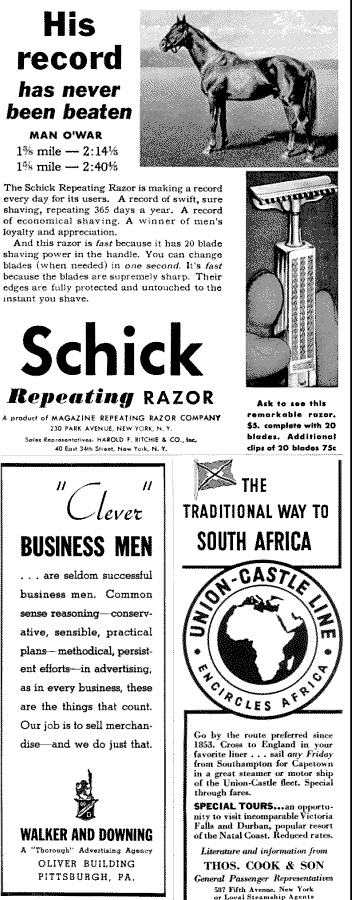
 |
Then the green matrix is pressed against the same strip of positive film. On this matrix, the spot corresponding to the red barn is a thick spot, so now the positive film gets a coating of magenta dye on the place that the red matrix missed. Then this same positive is pressed against the blue matrix. Here again the spot corresponding to the barn is a thick spot, so that over the coating of magenta dye there is added a coating of yellow dye. In the end the spot corresponding to the barn is stained with both magenta and yellow.
 Now the positive print is finished and the film is ready to be shown. The white light in the projecting camera has the same red, green, and blue elements that we have already noticed in sunlight. But as it shines through the colored film, the magenta holds up the green element and the yellow holds up the blue element. The only element that can get through is the red element, just as red was the only element that the red barn reflected. Once more, the barn spot on the film was stained with magenta and with yellow, hence only the red can pass through this portion of the film. Therefore your eye receives only a red sensation and on the screen you see a red barn. The dyes on the positive subtract the nonessential elements just as in nature the surface of the original object went through the same subtractive process. Now the positive print is finished and the film is ready to be shown. The white light in the projecting camera has the same red, green, and blue elements that we have already noticed in sunlight. But as it shines through the colored film, the magenta holds up the green element and the yellow holds up the blue element. The only element that can get through is the red element, just as red was the only element that the red barn reflected. Once more, the barn spot on the film was stained with magenta and with yellow, hence only the red can pass through this portion of the film. Therefore your eye receives only a red sensation and on the screen you see a red barn. The dyes on the positive subtract the nonessential elements just as in nature the surface of the original object went through the same subtractive process.
 There are many other color processes, including the three-color Keller-Dorian process that Paramount and Eastman Kodak have brought to the point of commercial use. But until this Paramount process has actually appeared before the cinema public, Technicolor remains as the only process that has had enough commercial experience to establish itself as unquestionably practical. The Technicolor process gives clear, natural colors in all their blends and variations. It is theoretically a perfect process; that is, the results achieved may be improved as the operating technique becomes more firmly established, but the three-component, imbibition (dye absorption) principle will always remain as Technicolor's basis. If there ever should be a purple cow, the Technicolor camera could bring it accurately and vividly before your eye. There are many other color processes, including the three-color Keller-Dorian process that Paramount and Eastman Kodak have brought to the point of commercial use. But until this Paramount process has actually appeared before the cinema public, Technicolor remains as the only process that has had enough commercial experience to establish itself as unquestionably practical. The Technicolor process gives clear, natural colors in all their blends and variations. It is theoretically a perfect process; that is, the results achieved may be improved as the operating technique becomes more firmly established, but the three-component, imbibition (dye absorption) principle will always remain as Technicolor's basis. If there ever should be a purple cow, the Technicolor camera could bring it accurately and vividly before your eye.
© Copyright 1934 - Time Incorporated
HTML Transcription and Graphic images
© Copyright 1999
The American WideScreen Museum
|

|
